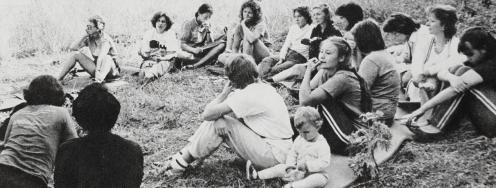Nuclear Upgrade Plans Conflict with Policy Goals, Budget Realities
On the radar: Triad overhaul imperils other priorities; $10-$20 billion for ALCM warhead; Not time to meddle with New START; Russia can’t afford its military plans either; Rouhani confident on deal, Zarif optimistic; Public opinion in Iran and Israel; Including China in arms control talks; and Kim limps into view.
October 14, 2014 | Edited by Jacob Marx and Will Saetren
Pivotal moment for triad - Replacing aging nuclear weapons is set to “drive the cost of the arsenal 75 percent higher in the next ten years than the last, and up to $1 trillion over the next thirty years...even as the overall defense budget is declining to meet the challenges of sequestration. There is a growing consensus among former and current officials that this plan for recapitalizing the nuclear triad is unaffordable under current budget constraints,” writes Adam Mount.
--”Though nuclear spending is formally exempted from sequestration, the military services are already finding that the scale of nuclear modernization endangers other priorities. And if the recent history of major procurement projects is any indication, each of the official estimates cited above is in distinct danger of delay and cost overrun.”
--”What is clear is that the current plans to replace the nuclear arsenal do conflict with the administration’s policy of reducing reliance on nuclear weapons. The administration seems set on replacing the triad to the detriment of conventional forces and assigning an increasing role for the nuclear arsenal. With Russia refining its penchant for aggression below the nuclear threshold, the White House ramping up counterterrorism operations in the Middle East, and a host of important domestic spending priorities imperiled, many will ask just how much the nuclear arsenal is worth.” Read the full column in Defense One. http://bit.ly/1vrg7bs
Air Force can’t justify LRSO - “The U.S. Nuclear Weapons Council has selected the W80-1 thermonuclear warhead for the Air Force’s new nuclear cruise missile (Long-Range Standoff, LRSO) scheduled for deployment in 2027...The enormous cost of the program – $10-20 billion by some estimates – is robbing defense planners of resources needed for more important non-nuclear capabilities,” writes Hans Kristensen for the Federation of American Scientists.
--”The only real argument for the new cruise missile seems to be that the Air Force currently has one, but it’s getting old, so it needs a new one. Add to that the fact that Russia is also developing a new cruise missile, and all clear thinking about whether the LRSO is needed seems to fly out the window.”
--”Rather than automatically developing and deploying a new nuclear cruise missile, the administration and Congress need to ask tough questions about the need for the LRSO and whether the money could be better spent elsewhere on non-nuclear capabilities that – unlike a nuclear cruise missile – are actually useful in supporting U.S. national and international security commitments.” Full analysis here. http://bit.ly/1sChKRj
Quit playing games with my START - “Tampering with New START is not in the United States’ interest,” writes Steven Pifer in a response to Stephen Rademaker’s Oct. 8th Washington Post article. “It could cause the treaty to unravel, at a time when Russia is building new strategic weapons—and the United States is not.”
--“A new strategic arms race is not an inviting prospect. While the Pentagon has its strategic modernization plans, new American ballistic missile submarines and long-range bombers will only begin to appear in the late 2020s. Moscow thus would enjoy a running head-start in any new strategic arms race. And doubts have already arisen about whether the U.S. defense budget can afford even the current modernization plans.” Read the full column over at Brookings. http://bit.ly/1o8X8Ak
Big plans, empty coffers - “Russia's ambitious, decade-long plan for the modernization and expansion of its military capabilities is imperiled by current trends in the global economy,” writes Nikolas K. Gvosdev in The National Interest. The proliferation of oil and gas exporters in global markets, annexation of the Crimea, and an already stagnant Russian economy are expected to take another hit as Western sanctions mount.
--What does this mean for Russia’s military modernization plans? “As long as a majority of the defense rearmament and modernization targets are hit, exact fulfillment on the existing schedule may be left by the wayside. This may be done either through reducing the size of procurement, or spreading out the program (currently expected to conclude in 2020) out along a longer time horizon. The Russian defense establishment may also learn to become comfortable with less—and decide, as in the case of nuclear weapons, that they can ensure their security with less." http://bit.ly/1tiixJi
Whew - “Missing Fort Carson item not a nuclear weapon — despite Internet rumors,” reports Tom Roeder in The Colorado Springs Gazette. http://1.usa.gov/11jc9F8
Rouhani certain - “Iranian President Hassan Rouhani said on Monday a nuclear deal with the West was bound to happen and he believed it could be achieved by a November 24 deadline,” reports Reuters. "We have reached consensus on generalities and there are only the fine details to be worked out: whether we would reach an agreement within the next 40 days, if the time will be extended, etc.," said Rouhani.
--"The nuclear issue is irreversible. I think a final settlement can be achieved in these remaining 40 days. We will not return to the situation a year ago. The world is tired and wants it to end, resolved through negotiations...A nuclear settlement is certain," he said, vowing to "apply all our efforts in that direction." Read the full story here. http://reut.rs/1p86VBJ
Zarif expects progress - If a deal is not reached by the November 24 deadline for P5+1 negotiations on Iran’s nuclear program, Iran’s chief nuclear negotiator expects at a bare minimum that “this round could pave the way for a final agreement,” reports Reuters. “Zarif's cautious optimism came a day after President Hassan Rouhani told Iranian television that a nuclear deal was ‘certain’ and that only ‘fine details’ remained to be negotiated.” Read the full story here. http://reut.rs/1sMgyuT
Critical week - “Analyst Kelsey Davenport from the Arms Control Association told AFP that this week's talks would be ‘critical’ and that a deal by November 24 was ‘still possible if both sides...are willing to be flexible and creative.’"
--”Iran's foreign minister said Tuesday ‘numerous questions’ remain unresolved as he arrived for fresh talks with the US and EU aimed at breaking a deadlock in efforts towards a nuclear deal. Read the full story here. http://yhoo.it/1ETf3ju
Public sentiments - Both the Iranian and Israeli populations “want the situation to de-escalate, and for their leaders to address other important domestic issues. The people of both Iran and Israel could live with the P5+1's current offer to Iran. It’s now up to their leaders, especially the supreme leader of Iran, who has the last word on Iran's nuclear program,” says Meir Javedanfar.
--Javedanfar writes that, while neither Israel nor Iran would get everything they wanted from a deal, such a deal would allow both countries to address their major concerns, avoid an downturn of relations and focus on more urgent national issues. Full article at Al-Monitor. http://bit.ly/1tqXe8D
Engaging China - “While U.S.-China relations will shape the broader security environment in the Asia-Pacific for the foreseeable future, cooperation and competition between China, the United States, and Russia will be key to the region’s nuclear outlook. Currently, these three states are engaged in a dynamic struggle for power and influence,” writes Alexei Arbatov for the Carnegie Moscow Center.
--”Strategic talks with China would… fit into the new U.S. policy of containing and isolating Russia, while promoting the noble cause of nuclear disarmament. In particular, they might allow Washington to deprive Russia of its unique global status—as the United States’ exclusive and equal partner in negotiations over an issue central to global military-political relations, which significantly affects many aspects of international security, including nonproliferation.” Read the full column here. http://ceip.org/1CYhL5a
Tweet - @ctbto_alerts: ES Zerbo met Sen. Lugar, discussed threat posed by #nuclear weapons proliferation & testing @TheLugarCenter #CTBT
Spotted - “According to the Korean Central News Agency, Mr. Kim recently visited a district where his government had just finished a cluster of homes for satellite engineers,” writes Choe Sang-Hun for the New York Times. It is the first time Kim Jong Un has appeared publicly since September 3, when he was reported to have attended a concert with his wife.
--”North Korea’s main party newspaper, Rodong Sinmun, dedicated the front page of its Tuesday edition to Mr. Kim’s reappearance in public after more than five weeks of absence… The paper carried a series of photos of Mr. Kim smiling and moving about with a cane... On Friday, he did not visit the mausoleum where his grandfather — Kim Il-sung, the country’s founder — and his father lie in state, skipping an important annual ritual he had previously performed to mark the anniversary of the founding of the ruling Workers’ Party.” Read the full story here. http://nyti.ms/1nkG09X
Quick Hits:
--“For SAC veterans, hot memories of the Cold War,” by Robin Caudell in the Plattsburgh Press-Republican. http://1.usa.gov/1tqZP2h
--“Criteria released for new Air Force nuclear medal,” by Jenn Rowell, Great Falls Tribune. http://gftrib.com/1p90Apr
--”Divergent Trajectories, the Bomb, and Kashmir,” by Michael Krepon for Arms Control Wonk. http://bit.ly/1scx85j
Events:
--"Solving the Iranian Nuclear Puzzle," featuring Robert Einhorn, Brookings Institution; Elizabeth Rosenberg, Center for a New American Security; and Alireza Nader, RAND Corporation. Part of the Arms Control Association annual meeting. 9:45-11:00 a.m., Oct. 20, at Carnegie Endowment, Root Room, 1779 Massachusetts Ave. NW, Washington. Register online. http://bit.ly/1vMTI66
--"The Unaffordable Arsenal: Reducing the Costs of the Bloated U.S. Nuclear Stockpile," featuring Tom Collina, Ploughshares Fund. Part of the Arms Control Association annual meeting. 11:00-11:30 a.m., Oct. 20, at Carnegie Endowment, Root Room, 1779 Massachusetts Ave. NW, Washington. Register online. http://bit.ly/1vMTI66
--Des Browne, former U.K. Defense Secretary, keynote speech. Part of the Arms Control Association annual meeting. Noon-12:55 p.m., Oct. 20, at the Carnegie Endowment, Root Room, 1779 Massachusetts Ave. NW, Washington. Register online. http://bit.ly/1vMTI66
--"The Future of the Nonproliferation and Disarmament Regime," featuring Assistant Secretary of State Thomas Countryman and Guakhar Mukhatzhanova, Monterey Institute. Part of the Arms Control Association annual meeting. 1:00-1:30 p.m. Oct. 20, At Carnegie Endowment, Root Room, 1779 Massachusetts Ave. NW, Washington. Register online. http://bit.ly/1vMTI66
--"The Future of U.S. Nuclear Weapons Policy," featuring Rose Gottemoeller, Undersecretary of State for Arms Control and International Security. Oct. 21, 1:30-2:30 p.m., Weber State University, Elizabeth Hall, Room 229, Ogden, UT.” http://bit.ly/ZY1r6B
--"The Future of U.S. Nuclear Weapons,” featuring Rose Gottemoeller, Undersecretary of State for Arms Control and International Security. 1:00-2:00 p.m., Oct. 22, University of Utah, Spencer Hall, Hinckely Caucus Room, 260 Central Campus Drive, Salt Lake City. http://bit.ly/1w0diMc
--"Debate: Should the United States Cut its Nuclear Arsenal?" Featuring Adam Mount, Council on Foreign Relations; Tom Collina, Ploughshares Fund; Matthew Kroenig, Georgetown University; and Thomas Moore, Wilson Center. Oct. 23, 6:00-8:00 p.m., George Washington University, Room B17, 1957 E St. NW, Washington. RSVP online. http://bit.ly/1w0dQSi



